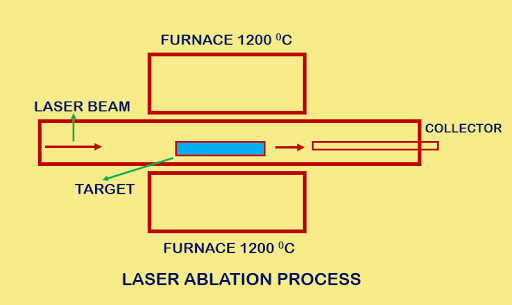CARBON NANOTUBES
Carbon nanotubes have seamless cylindrical structure contains one or more graphene layers, there are single wall carbon nanotube (SWCNT) and multi wall carbon nanotube (MWCNT), with open or closed ends. For perfect structure of carbon nanotubes the bonding of all carbons in carbon nanotubes are in hexagonal lattice except at their ends, other bonding patterns are pentagons, heptagons.The fundamental carbon nanotube is a single wall structure and best described as a rolled-up tubular shell of graphene sheet, the body of the tubular shell is made up of hexagonal rings (in a sheet) of carbon atoms, where as the ends are capped by a dome-shaped half fullerene molecules. Diameter of single wall carbon nanotube is 0.8 - 2 nm.The arrangement of the carbon atoms in the hexagonal network of the multi wall carbon nanotube is often helicoidal, resulting in the formation of chiral tubes. Multi wall carbon nanotube will typically be composed of a mixture of cylindrical tubes having different helicity or no helicity, thereby resembling turbostratic graphite. Diameter of multi wall carbon nanotube is 2 - 20 nm.
SYNTHESIS OF CARBON NANOTUBES
Carbon nanotubes can be prepared by varius ways, such as arc discharge, laser ablation, chemical vapor deposition (CVD), electrolysis, flame synthesis etc.
1. Arc Discharge ---
For the synthesis of carbon nanotubes this is one of the oldest method . 4-30 nm in diameter and 1 mm in length carbon needles were grown on the negative electrode used for the direct current (DC) arc discharge. A gas mixture of 10 Torr methane and 40 Torr argon filled in a pressurised chamber used during the process. Two thin electrodes installed vertically in the center of the chamber. The cathode, that is the lower electrode had a shallow dip to hold a small piece of iron during the evaporation. A DC current of 200 A and 20 V was used between the electrodes for the generation of arc. For the synthesis of single wall carbon nanotube (SWCNT) the use of three components such as methane, argon and iron was essential. As a result of arc discharge carbon soot was produced and carbon nanotubes grew in the negative cathode that contained a iron catalyst. The diameter of the nanotubes distributed between 0.7 nm to 1.65 nm.
2. Laser Ablation ---
A pulsed laser is made to strike at graphite target in the laser ablation process, in the presence of a inert gas such as helium in a high temperature reactor for vaporizes a graphite target. As the vaporized carbon condenses the nanotubes were developed on the cooler surfaces of the reactor. For the vaporization of target more rapidly a second pulse was used, that is in this process two step laser ablation was used. The benefit of two step laser process for minimised the carbon deposited as soot. In this method tubes grow on catalysts atoms and grows continued until to many catalysts atoms aggregate at the end of the tube. The produced carbon nanotubes diameter was 10 - 20 nm and length was 100 micron or more. By varying the reaction condition such as temperature, catalyst composition the average diameter and length of the produced carbon nanotubes could ve varied.
3. Chemical vapor deposition (CVD) ---
For the production of carbon nanotubes in large scale chemical vapor deposition (CVD) is a useful method. This method is very useful for controlling the growth of carbon nanotubes. In this process in the reaction chamber at a temperature of (700 0C – 900 0C) and at atmospheric pressure a mixture of hydrocarbon gases such as methane, ethylene, acetylene and process gases such as hydrogen, nitrogen, ammonia is made to react on heated metal substrate. Since hydrocarbon gas deposit and grows on metal catalysts (substrate), so carbon nanotubes was formed. On growing carbon nanotubes catalyst particles can stay at the bottom or on the top. The choice of metal catalysts and substrate were very important because they controlled the nature and type of carbon nanotubes. Generally silicon used as a substrate, sometimes aluminium even glass used as a substrate. Fe, Co, Ni metal nanoparticles were used as a catalyst. The diameter of the nanotube depends on the catalyst and substrate.














No comments:
Post a Comment